|
In this region there are
altogether 3 species. They are differentiated by:-
[a] the manner the fertile
fronds carry the spores, [b] variations in the measurement and profile of the
fronds.
Species found here are the
:-
| Central
Peninsula -up north -
P. coronarium |
| Southern
Peninsula - P.
ridleyi |
| Northern
Peninsula - P.
wallichi |
The most common and
also attractive with its lengthy leaves is The majestic
Platycerium
coronarium.
This plant is found in Central
Peninsula Malaysia and then, northwards in Thailand.
 |
It is recognized by its fertile
leaves
long and pendulous.
They nest on very old trees in low
elevation along roadsides or on the upper branches of the tallest tree in
the primitive forest. |
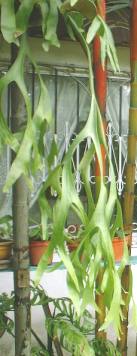 |
Nest leaves
-when living erected
have free upper edges up to 60 cm and sinuses of 25 cm deep.
Fertile
leaves -Fertile leaves
are up to 200 cm long limply pendulous and repeatedly dichotomous. The 3
forking are very unequal.
Fertile lobe
- Shortly stalked, semi circular about
25 cm round. Very broad base, is wider than the length. Fleshy and the
whole concave lower surface covered with a dense felt of stellate hair.
|
This long pendulous fertile
leaf frond is produced one at a time. Not specifically any period but irregular
intervals. At any one time, the plant normally carries 3 fertile leaves to each
branch of the rhizome.
Together with the P.
wallichii, these 2 species are commonly seen in Peninsula Malaysia. Below is a
picture to distinguish them
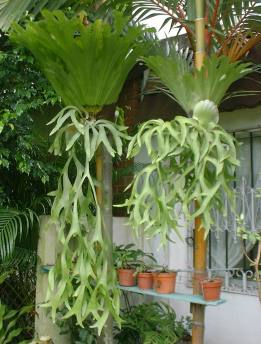 |
The 2 plants growing
side by side in my own garden
Distinctive characteristics?
P. wallichii produces new leaf frond
in pairs, usually in each growing season.
P. coronarium are produced one at a
time at irregular intervals.
Then the P.coronarium has pendulous
leaf frond while that of the P. wallichii are more erect. |

Platycerium
wallichii are native to the
more northern region of the Peninsular
 |
They are
seen more often in places north of Penang Island.
i.e. Thailand down to Langkawaii.
|
This fern is found in
fairly exposed area, in fact some plants were collected growing on trees by the
seaside.
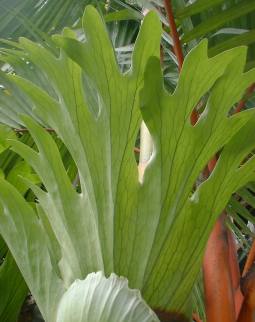 |
Nest leaves
-are 60 cm or more , as wide
and long, erected and much lobed. Sinuses are about half way to the base.
[picture left]
Fertile leaves
-produced in pairs, [see picture below]
about 60 cm long. The lamina extending down to the broadly cuneate base.
Rarely longer than nest leaves.
Fertile lobe
- Not as a separate structure.
sporangia are found on the lower surfaces [Very prominent as convex
rounded lobes] of first 2 sinuses of leaf fronds. |
An equally large plant as
the P.coronarium. With equal size nest and fertile fronds, the plant ends up
looking shorter.
The sporangia are larger
than those of the P.coronarium. hidden in thinner layer and covered by a felt of
uniform length stellate hairs.

Platycerium ridleyi
found in the southern Peninsular, the islands of Borneo and Sumatra.
This is a much smaller
plant as compared to the other 2 mentioned above. Unlike other Platycerium, the
nest-leaf fronds of this plant do not form a open basket.
| Some
collections had being made in the riversides in Johore.
It had also being seen along the
East Coast states of Pahang and Trenggannu. |
|
They do grow on low
branches but never in open or developed areas. The principal differences from
the P. coronarium are:-
|
Whole plant - much
smaller in size than the P. coronarium |
|
Nest leaves - slightly
lobed with the upper edges not erected but inflexed. |
|
Fertile leaves - 2
short ascending repeatedly forked sterile branches and one fertile lobe. |
|
Fertile lobe - widening
from a narrow base, almost circular, longer than wide and strongly concave
beneath. About 6 cm long. |

For comparison with
pictures of Stag's horn commonly found in books, here are pictures some of the
non- Malaysian plants.
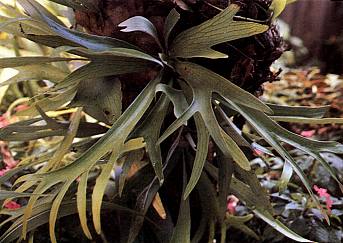 |
The
Platycerium
wallichii is the nearest
ally to the Australian
Platycerium
grande.
|
|
|
The Australian has
their Elkhorn,
the
Platycerium
bifurcatum |
|
|
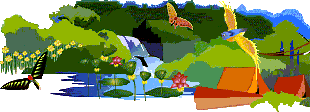

![]()